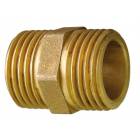Brass fittings for hydraulic use
Brass fittings are used in almost all types of fittings for hydraulic use, as the metal has excellent properties well suited for this type of use
 The brass hydraulic fittings are a product of fundamental importance for the connection and construction of domestic and civil plumbing systems. Within the Gnali Bocia catalog there are numerous models and this allows to meet the needs of a wide range of customers.
The brass hydraulic fittings are a product of fundamental importance for the connection and construction of domestic and civil plumbing systems. Within the Gnali Bocia catalog there are numerous models and this allows to meet the needs of a wide range of customers.
The production process of brass hydraulic fittings
Despite the different types of brass hydraulic fittings available, the production process is almost similar. In fact, starting from the raw material, namely CW 617 N and CW 614 N brass, which is supplied in the form of bars according to UNI certifications, we proceed with a first forming step. What does this first operation consist of? It is a hot forging, that is a plastic deformation process in which the material is brought above the recrystallization temperature and is worked by hammer or press strokes in order to irreversibly modify the shape of the bar, bringing it closer to that of the final fitting to be obtained.Once this phase is completed, further finishing operations are carried out by chip removal using TRANSFER CNC machines which allow to reach the final shape of the hydraulic fitting starting from a raw semi-product deriving from the previous forging operations. Also in this phase we also proceed with operations to improve the surface finish of the component, a requirement that can be important for the subsequent phases of product preparation.
After the mechanical operations, surface treatments of nickel and chrome plating are carried out. These treatments consist in the superficial deposition of a layer of nickel followed by a flash of chromium to ensure that the component increases its resistance to corrosion, improving not only its efficiency but also its duration over time and, therefore, leading to a reduction in costs of maintenance and replacement once the fitting is put into operation.
The assembly of brass hydraulic fittings
The hydraulic brass fittings also require the installation and assembly phases. These phases are carried out with the aid of automated and robotic processes that guarantee some advantages that are difficult to obtain through manual assembly:- Production speed: the use of robots reduces time and increases production;
- Repeatability: it is possible to eliminate the human error present in manual assembly;
- Quality: the automation of this phase increases the quality obtained with the same implementation of the previous steps.
Final stages prior to delivery
Before proceeding with the packaging and shipping of the brass hydraulic fittings, Gnali Bocia subjects its products to a series of tests to verify that these fittings correspond to the requirements of the standards and customers, evaluating both the qualitative aspect and the tolerances present.23/03/2021
I contenuti di questo sito non hanno carattere di periodicità e non rappresentano 'prodotto editoriale'.








